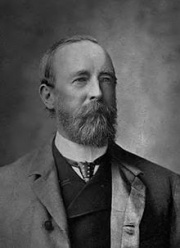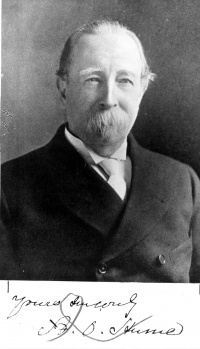Allan Octavian Hume
Allan Octavian Hume (6 June 1829 - 31 July 1912) was a civil servant, political reformer and amateur ornithologist and horticulturalist in British India. He was one of the founders of the Indian National Congress, a political party that was later to lead the Indian independence movement.
Bio-data
A. O. Hume was born in St Mary Cray, Kent, on 6 June 1829. He was the grandson of an East India Company director. He was educated at East India Company College, Haileybury, and then at University College Hospital, in London, where he studied medicine and surgery.
In 1849 young Hume sailed to India. In 1853 he married Mary Anne Grindall, with whom he had a daughter. His wife Mary died in 1890.
Hume left India in 1894 and settled at The Chalet, 4, Kingswood Road, Upper Norwood in London. He died at the age of eighty-three on 31 July 1912. His ashes are buried in Brookwood Cemetery. In 1973, the Indian postal department released a commemorative stamp.
Political career
In 1850 Hume joined the Bengal Civil Service. In his early service as a District Officer he began introducing free primary education and creating a local vernacular newspaper, Lokmitra (The People's Friend) in Etawah, the town of present-day Uttar Pradesh. He also founded scholarships for higher education, and maintained that education would play a key role in avoiding revolts like the Indian Rebellion of 1857. In 1863 he moved for separate schools for juvenile delinquents rather than imprisonment. His efforts led to a juvenile reformatory. By 1857 he established 181 schools with 5186 students including two girls. With his progressive ideas about social reform, he advocated women's education, was against infanticide and enforced widowhood.
Hume laid out in Etawah a commercial district known as Humeganj. The high school that he helped build with his own money is still in operation, now as a junior college, and it was said to have a floor plan resembling the letter H. This, according to some was an indication of Hume's imperial ego.[1]
By 1870 he had risen to become Director-General of Agriculture in the central government. But he was having problems with his colleagues, and now his reformist policies became more controversial. He was very outspoken and never feared to criticise when he thought the Government was in the wrong, often intruding into every aspect of administration with his critical opinions.
Hume was critical of the land revenue policy and suggested that it was the cause of poverty in India. Hume proposed to develop fuelwood plantations to provide a substitute heating and cooking fuel so that manure could be returned to the land. His superiors were irritated and attempted to restrict his powers and was eventually demoted. This led him to publish a book on Agricultural Reform in India in 1879. In 1879 he returned to provincial government at Allahabad. He went against the authorities and the Government of Lord Lytton dismissed him from his position in the Secretariat. The press declared that his main wrong doing was that he was too honest and too independent. He finally retired from the civil service in 1882.
Indian National Congress
His main contribution to Indian life was in founding the Indian National Congress (INC). He had long sympathized with those who suffered under what he regarded as mistaken policies. In 1883 he wrote an open letter to the graduates of Calcutta University, calling upon them to form their own national political movement. The idea took off and, after some initial developments, lead to the first session of the INC in Bombay, in 1885.
In 1887 he wrote to the Public Commission of India stating — I look upon myself as a Native of India.
His work in ornithology
Hume was always interested in science. He became an outstanding authority as an ornithologist, for he pursued his hobbies with the same zeal as he pursued his political ideals. Hume has been called "the Father of Indian Ornithology" and, by those who found him dogmatic, "the Pope of Indian ornithology."
He built a systematic plan to survey and document the birds of the Indian Subcontinent. He made several expeditions to collect birds, both on health leave and where work took him, and in the process he accumulated the largest collection of Asiatic birds in the world, which he housed in a museum and library at his home in Rothney Castle on Jakko Hill, Simla.
He made many new identifications, and a number of Indian species were given their common names by him (Hume's Babbler, Hume's Bush Warbler and so on).
He was preparing a massive publication on all the birds of India, but this work was lost in 1885 when all his manuscripts were stolen and sold by a servant as waste paper. This event, as well as a damage of his personal museum and specimens caused by heavy rains in Simla made Hume reduce his interest in ornithology. He wrote to the British Museum wishing to donate his collection on certain conditions that the Museum was unable to meet. It was only after the destruction of nearly 20000 specimens that the Museum authorities visited India in 1884 to take care of the specimens. The Hume collection of birds consisted of 82,000 specimens of which 75,577 were finally placed in the Museum.
Theosophy
Notes
- ↑ Agricultural Development in British India by Bret Wallach.
Further reading
- Triad at Theosopedia

